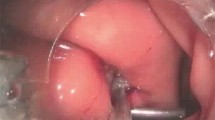Abstract
Background
Two decades ago, minimally invasive surgery (MIS) was introduced and led to a revolution in modern surgery. Currently MIS procedures are the standard of care for many surgical interventions and patients often seek out surgeons with special training in MIS. Today, natural orifice transluminal endoscopic surgery (NOTES) appears to be on the threshold of another such revolution. We surmise that its advantages are similar to those of other MIS procedures, but there are no associated abdominal wall complications as there are no abdominal incisions. To date, there is no data evaluating women’s perceptions of such a procedure and their willingness to consent to this type of surgical approach.
Methods
We surveyed 100 women who were given a written description of MIS and NOTES surgery along with a 10-question survey exploring their concerns and opinions regarding transvaginal surgery.
Results
The majority of women (68%) indicated that they would want a transvaginal procedure in the future because of decreased risk of hernia and decreased operative pain (90 and 93%, respectively), while only 39% were concerned with the improved cosmesis of NOTES surgery. Of the women polled, nulliparous women and those under age 45 years were significantly more often concerned with how transvaginal surgery may affect healthy sexual life and fertility issues (p < 0.05). Of the women who would not prefer transvaginal surgery, a significant number indicated concerns over infectious issues (p < 0.05).
Conclusions
Our study shows that there is considerable public interest in NOTES surgery and women would be receptive to this new surgical technique. Our study highlights a strong need for early reporting of outcomes data to enlighten ourselves, and our patients, about this exciting new technology.

Similar content being viewed by others
References
Volkmann E, Hungness ES, Soper NJ (2007) Patient perceptions of natural orifice transluminal surgery (NOTES). Surg Endosc 21:S349
Varadarajulu S, Tamhane A, Drelichman ER (2008) Patient perception of natural orifice transluminal endoscopic surgery as a technique for cholecystectomy. Gastroint Endosc. doi:10.1016/j.gie.2007.09.053
Meltomaa SS, Makinen JI, Taalikka MO, Helenius HY (1999) One-year cohort of abdominal, vaginal, and laparoscopic hysterectomies: complications and subjective outcomes. J Am Coll Surg 189:389–396
Kafy S, Huang JY, Al-Sunaidi M, Wiener D, Tulandi T (2006) Audit of morbidity and mortality rates of 1972 hysterectomies. J Minim Invasive Gynecol 13:55–59
Long CY, Fang JH, Chen WC, Su JH, Hsu SC (2002) Comparison of total laparoscopic hysterectomy and laparoscopically assisted vaginal hysterectomy. Gynecol Obstet Invest 53:214–219
Candiani GB, Candiani M (1996) Posthysterectomy fallopian tube herniation. A report of two cases. J Reprod Med 41:915–920
Author information
Authors and Affiliations
Corresponding author
Appendices
Appendix A: Transvaginal surgery study
The purpose of this anonymous survey is to illicit the opinions and attitudes of women towards a new proposed surgical technique called transvaginal surgery.
Laparoscopic surgery revolutionized surgery during the 1980s and 1990s changing the approach to surgical procedures. Laparoscopic surgery involves making small abdominal incisions on the abdominal wall to perform abdominal surgery instead of a large abdominal wall incision. Laparoscopic procedures are now the standard of care for many operations such as the laparoscopic cholecystectomy (removal of the gallbladder) or removal of the appendix. Many more operations are performed laparoscopically with patients seeking surgeons who have acquired these skills to perform their surgery as they have read about the advantages of laparoscopy. Some of them include decreased pain, faster return to work, less wound infections and hernias, shorter hospital stays, and better cosmetic results because of smaller incisions.
What is NOTES?
Natural orifice transluminal endoscopic surgery (NOTES) has gained much interest by surgeons as the next step in development of new less invasive techniques. This new and evolving technique uses natural orifices, such as the mouth, anus, and vagina to gain access to the abdomen to perform abdominal operations instead of incisions on the abdominal wall. Some of the advantages of NOTES over laparoscopic surgery are that it eliminates risk of hernia formation through an abdominal scar and eliminates visible scarring altogether. This could also potentially reduce postoperative pain. Other potential advantages are that wound infection rates may decrease, and patients will return to work sooner and recover quicker.
How is it done?
Under anesthesia, a hole is made in the vagina on the inside which allows placement of instruments and camera through this hole to perform an operation. Entering the abdominal cavity or belly through the vagina mandates an incision on the wall of the vagina, but eliminates a belly wall incision. Fertility specialists have performed transvaginal procedures to procure oocytes and do other gynecologic/obstetrical procedures in the past. There is no evidence thus far to suggest a negative impact on fertility for the patient.
Appendix B: Transvaginal surgery study

Rights and permissions
About this article
Cite this article
Peterson, C.Y., Ramamoorthy, S., Andrews, B. et al. Women’s positive perception of transvaginal NOTES surgery. Surg Endosc 23, 1770–1774 (2009). https://doi.org/10.1007/s00464-008-0206-4
Received:
Revised:
Accepted:
Published:
Issue Date:
DOI: https://doi.org/10.1007/s00464-008-0206-4




